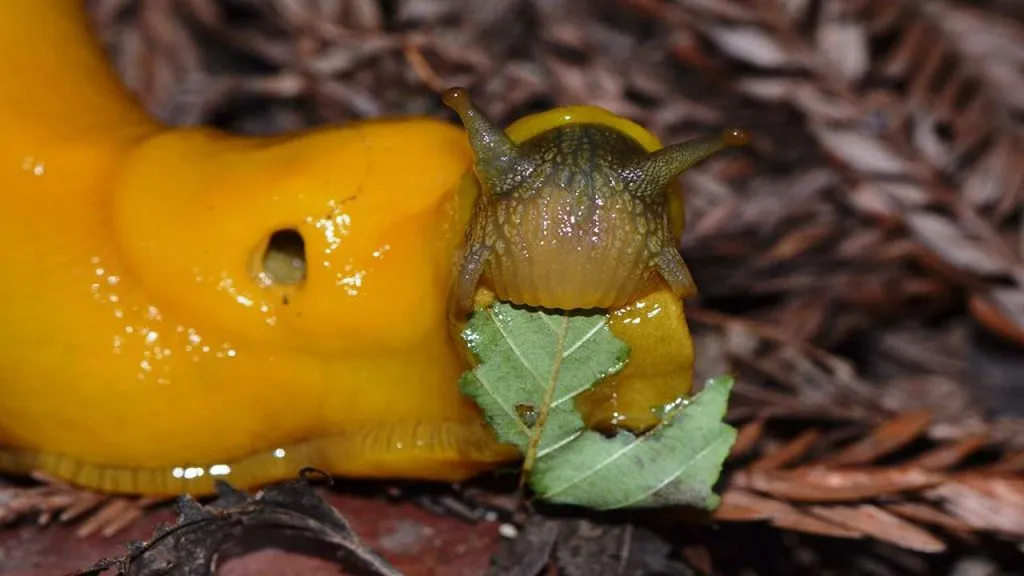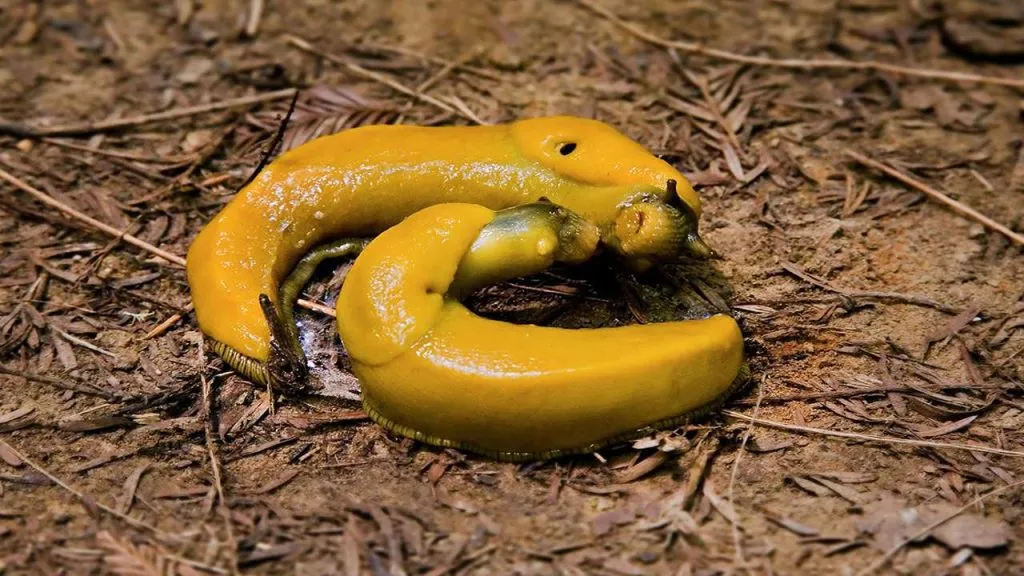As an Amazon Associate I earn from qualifying purchases.
Banana slugs stand out as some of the largest slugs globally, with lengths reaching up to 30 cm (12 in), though they typically measure between 10 and 20 cm (4-8 in).
Their coloration ranges from yellowish to brown, often adorned with black spots on their backs. The heaviest recorded banana slug weighed in at 454 grams (1.001 lb).
These slugs sport a slimy, mucus-coated exterior, aiding in their locomotion and preventing dehydration. Beneath this layer, they harbor hundreds of small, sharp teeth.
These teeth come in handy for devouring decaying leaves, flowers, and various plant matter.
Despite being hermaphrodites, possessing both male and female reproductive organs, banana slugs still rely on mating to reproduce.
During this process, sperm exchange occurs between the two slugs, facilitating fertilization of their respective eggs.
The bright yellow bodies and slippery trails of banana slugs often spark interest among both nature lovers and scientists.
A commonly asked question about these creatures is, “What exactly do banana slugs consume?”
This article explores the dietary choices of banana slugs, how their eating habits change throughout the year, where they prefer to live, and some fascinating details about these gooey gastropods.
What Do Banana Slugs Eat?

Even though they’re called banana slugs, these creatures eat a variety of foods found in the forests where they live.
Most of their diet is made up of old plants and other natural stuff that’s breaking down.
They munch on all sorts of leaves, from those that fall off trees all year round to ones that are starting to rot.
They also enjoy snacking on different kinds of fruits like berries, apples, and oranges that fall from trees and plants.
Surprisingly, they even like to nibble on flower petals and the parts of flowers where seeds are made, like those from wildflowers or flowers you’d find in a garden.
In their forest homes, they’ll also eat mosses, which are like tiny plants, and lichens, which are a mix of fungi and algae.
Banana slugs are big helpers in the forest because they help break down fungi, like mushrooms, and other things that are rotting.
Sometimes, they’ll eat algae stuck to rocks and trees too. And although it’s not their favourite, they’ll eat dead animals and their poop, which helps to keep the forest clean.
Now and then, they might even take a bite of young plants, but they mostly stick to eating old, rotting stuff.
It’s important to know that banana slugs are pretty flexible eaters, and what they eat depends on what’s available in the season and where they are.
But no matter what they’re eating, they play a big role in keeping the forest healthy by recycling nutrients and making sure everything stays balanced.
Here is a list of foods that banana slugs eat
- Leaves
- Fruits
- Flowers
- Mosses
- Lichens
- Fungi
- Algae
- Dead animals
- Animal poop
- Young plants
What Do Banana Slugs Eat in the Winter?
In winter, banana slugs eat whatever they can find around them. Although fresh plants may be scarce, they still munch on old, rotting stuff like leaves, fruits, and flowers.
They also snack on things like mosses, lichens, fungi, and algae, which are still around in the forests during the colder months.
Even though their diet might change a bit because of the season, banana slugs are flexible eaters and make do with whatever food is available to them in winter.
What Do Baby Banana Slugs Eat?
Just like grown-up banana slugs, baby banana slugs are also into eating decaying plant matter.
When they first hatch, usually in groups of several dozen, they go for the smaller, easier-to-digest pieces of food.
Because they’re tinier, they might prefer the softer parts of fallen leaves or fruits that are starting to rot.
They can also snack on microscopic spores that are all over the place in their environment.
These young slugs find it easier to handle soft fungi rather than the tougher, fully-grown mushrooms.
They’re not too picky either; they’ll munch on tiny bits of animal waste just like the adults do. On top of all that, they might also nibble on mosses, lichens, fungi, and algae.
As they get bigger, their tastes start to match those of the grown-up banana slugs.
Where Do Banana Slugs Live?
Banana slugs usually live in wet forests and woods, mainly in the Pacific Northwest of North America.
They make their homes in places like forests, woods, and soggy meadows. These areas have enough moisture, shade, and rotting plants for banana slugs to do well.
They can live in different kinds of habitats, from thick forests full of leaves to more open spots with lots of plants.
As long as there’s enough food and moisture around, banana slugs can live in lots of different places within their range.
How Do Banana Slugs Find Its Food?
Banana slugs mainly use their strong sense of smell to find food.
They have special receptors on their tentacles that can pick up the scent of rotting plants like fallen leaves, fruits, and flowers.
Once they catch a whiff of something tasty, they slide along the ground using their muscular foot, leaving a slimy trail behind them.
This slime acts like a guide, helping them find their way to the food and also letting other slugs know where to go.
When they reach their meal, they use their rough mouthparts to munch on the decaying stuff. Sometimes, they might also feel around with their bodies to explore and find food.
Overall, their amazing sense of smell and ability to follow slime trails are crucial for banana slugs to find their food in the woods.
How do banana slugs benefit our environment?
Banana slugs play a crucial role in our ecosystem for several reasons. Firstly, they contribute to soil health by aerating it as they burrow through it.
This action enhances water absorption and prevents soil compaction, which is important for plant growth.
Moreover, banana slugs act as natural composters by breaking down organic matter on the forest floor, releasing essential nutrients that plants require to thrive.
Interestingly, the slime produced by banana slugs possesses medicinal properties that can combat certain plant diseases, offering a natural defense mechanism.
But perhaps the most significant aspect of banana slugs is their position in the food chain. Many animals, including snakes, birds, and rodents, rely on banana slugs as a food source.
Without them, these animals would struggle to find sustenance. Additionally, banana slugs help regulate populations of other pests like snails and slugs, which can otherwise damage crops and gardens.
Furthermore, the slime of banana slugs has been utilized in making toys, adding a touch of amusement to their already beneficial presence.

Interesting Facts About The Banana Slugs
1. Big Slugs: Banana slugs are among the largest types of land slugs, with some growing up to ten inches long.
2. Bright Yellow Warning: Their vivid yellow color is like a warning sign to animals that they taste bad and can release toxins.
3. Both Genders: Banana slugs have both male and female parts, so they can mate with any other slug they meet.
4. Ecosystem Helpers: They’re important for keeping forests healthy by breaking down old plants and adding nutrients to the soil.
5. Surprisingly Fast: Despite their slow-moving appearance, banana slugs can zip around pretty quickly, thanks to the slime they leave behind.
6. Long Lives: Banana slugs usually live for a few years in their natural homes.
7. Night Owls: They’re most active at night when it’s cooler and damp.
8. Watch Out for Predators: Even though they can make toxins, banana slugs still have to watch out for animals like birds and rodents that might want to eat them.
9. Taking a Break: When the weather gets really bad, like in extreme cold or drought, banana slugs can go into a kind of sleep to save energy until things get better.
10. Cultural Meaning: Some Native American tribes see banana slugs as symbols of change and renewal, showing how important they are for the forest’s health.
Conclusion
To sum up, banana slugs are really interesting critters with different eating habits and important jobs in nature.
When we learn about what they eat and how they fit into their surroundings, it helps us understand how nature works together.
So, if you ever see a banana slug in the woods, take a moment to think about how cool it is and how it helps keep our world in balance.
FAQ’s:
Yes, it’s generally okay to touch banana slugs gently. They don’t pose any harm to humans, and many people find them fascinating to observe.
Just make sure your hands are clean, and try not to handle them too roughly.
No, banana slugs don’t bite humans. They don’t have teeth, so they can’t bite like some other animals do.
However, they do have a slimy coating on their bodies, which some people might find unpleasant to touch.
Banana slugs can live for several years in their natural habitat.
The exact lifespan can vary depending on factors like environmental conditions and predators, but they typically survive for a few years, contributing to their role in forest ecosystems.
Amazon and the Amazon logo are trademarks of Amazon.com, Inc, or its affiliates.

